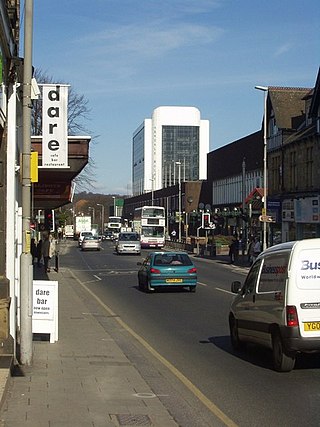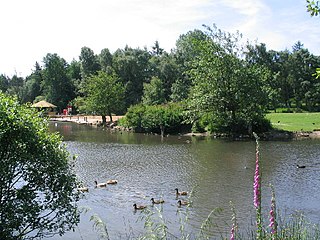
Otley is a market town and civil parish at a bridging point on the River Wharfe, in the City of Leeds metropolitan borough in West Yorkshire, England. Historically a part of the West Riding of Yorkshire, the population was 13,668 at the 2011 census. It is in two parts: south of the river is the historic town of Otley and to the north is Newall, which was formerly a separate township. The town is in lower Wharfedale on the A660 road which connects it to Leeds.

Arthington is a linear village in Wharfedale, in the City of Leeds metropolitan borough in West Yorkshire, England. It is a civil parish which, according to the 2011 census, had a population of 532. It is in the Otley ward of the City of Leeds, and the Leeds North West parliamentary constituency.

Headingley is a suburb of Leeds, West Yorkshire, England, approximately two miles out of the city centre, to the north west along the A660 road. Headingley is the location of the Beckett Park campus of Leeds Beckett University and Headingley Stadium.

Cookridge is a suburb of north-west Leeds, West Yorkshire, England, north of the Leeds Outer Ring Road. In 1715 Ralph Thoresby described it as a village four miles from Leeds and three from Otley, dating from 1540.

Adel is a suburb of Leeds, West Yorkshire, England. To its immediate south is Weetwood, to the west are Cookridge and Holt Park, to the east are Alwoodley and Moortown, and to the north are Bramhope, Arthington and Eccup.

The A660 is a major road in the Leeds and Bradford districts of West Yorkshire, England that runs from Leeds city centre to Burley-in-Wharfedale where it meets the A65. The A660 is approximately 10 miles (16 km) long, and crosses the watershed from Airedale to lower Wharfedale. For most of its length the road is in the metropolitan district of the City of Leeds; the last 0.4 miles (0.6 km) is in City of Bradford district.

Golden Acre Park is a public park in Bramhope, Leeds, West Yorkshire, England, administered by Leeds City Council. It is on the A660 Otley Road and covers an area of 179 acres (72 ha).

Bramhope Tunnel is on the Harrogate Line between Horsforth station and the Arthington Viaduct in West Yorkshire, England. Services through the railway tunnel are operated mainly by Northern. The tunnel was constructed during 1845–1849 by the Leeds and Thirsk Railway. It is notable for its 2.138-mile (3.441 km) length and its Grade II listed, crenellated north portal. The deaths of 24 men who were killed during its construction are commemorated in Otley churchyard by a monument that is a replica of the tunnel's north portal.

Breary Marsh is a Local Nature Reserve and Site of Special Scientific Interest situated adjacent to Golden Acre Park in Leeds, West Yorkshire, England, grid reference SE264416.

West Yorkshire is a metropolitan county in the Yorkshire and the Humber region of England. Created as a metropolitan county in 1974 after the passage of the Local Government Act 1972, it consists of five metropolitan boroughs, namely the City of Bradford, Calderdale, Kirklees, the City of Leeds and the City of Wakefield. Its area corresponds approximately with the historic West Riding of Yorkshire, and it contains the major towns of Bradford, Dewsbury, Halifax, Huddersfield, Leeds, and Wakefield.
Otley is a civil parish in the metropolitan borough of the City of Leeds, West Yorkshire, England. It contains 152 listed buildings that are recorded in the National Heritage List for England. Of these, one is listed at Grade I, the highest of the three grades, two are at Grade II*, the middle grade, and the others are at Grade II, the lowest grade. The parish contains the market town of Otley and the surrounding countryside. Most of the listed buildings are in the town, and consist of houses, cottages and associated structures, shops, public houses, and commercial buildings. The other listed buildings include churches, chapels and items in churchyards, farmhouses and farm buildings, buildings associated with a former mill, public buildings, schools, milestones, former workhouse buildings, a clock tower, a war memorial and garden, and telephone kiosks.
Wetherby is a civil parish in the metropolitan borough of the City of Leeds, West Yorkshire, England. The parish contains 33 listed buildings that are recorded in the National Heritage List for England. All the listed buildings are designated at Grade II, the lowest of the three grades, which is applied to "buildings of national importance and special interest". The parish contains the town of Wetherby and the surrounding area. The listed buildings include houses and associated structures, road and railway bridges, churches, public houses, a bath house, former farm buildings, a town hall, a former railway engine shed, and two mileposts.
Guiseley and Rawdon is a ward in the metropolitan borough and Rawdon is a civil parish in the City of Leeds, West Yorkshire, England. This list also contains the listed buildings in Otley and Yeadon ward. The wards and parish contain 99 listed buildings that are recorded in the National Heritage List for England. Of these, one is listed at Grade I, the highest of the three grades, three are at Grade II*, the middle grade, and the others are at Grade II, the lowest grade. The wards and parish contain the towns of Guiseley and Yeadon, the villages of Rawdon and Hawksworth, and the surrounding area. Most of the listed buildings are houses, cottages and associated structures, farmhouses and farm buildings. The other listed buildings include churches and items in churchyards, a village cross, a school, a former hospital, a railway bridge, a railway tunnel portal and retaining walls, a former tram shed, a town hall, and a telephone kiosk.
Bramhope is a civil parish in the metropolitan borough of the City of Leeds, West Yorkshire, England. It contains 20 listed buildings that are recorded in the National Heritage List for England. Of these, one is listed at Grade I, the highest of the three grades, and the others are at Grade II, the lowest grade. The parish contains the village of Bramhope and the surrounding countryside. Of the listed buildings, nine are mileposts, and the others include houses, farmhouses and farm buildings, a chapel and a church, the north portal of Bramhope Tunnel and a sighting tower used in the construction of the tunnel, and a gazebo.
Garforth and Swillington is a ward and Swillington is a civil parish in the metropolitan borough of the City of Leeds, West Yorkshire, England. The ward and parish contain 22 listed buildings that are recorded in the National Heritage List for England. Of these, two are listed at Grade II*, the middle of the three grades, and the others are at Grade II, the lowest grade. The area covered by the list includes the town of Garforth, the village of Swillington, and the surrounding countryside. The listed buildings include houses and associated structures, farmhouses, churches, a sundial in a churchyard, road and railway bridges, and mileposts.
Aberford and Lotherton cum Aberford are adjacent civil parishes in the metropolitan borough of the City of Leeds, West Yorkshire, England. The parishes contain 25 listed buildings that are recorded in the National Heritage List for England. Of these, one is listed at Grade II*, the middle of the three grades, and the others are at Grade II, the lowest grade. The parishes contain the village of Aberford and the surrounding countryside, including the area around Lotherton Hall. Most of the listed buildings are houses and cottages, and the others include churches, a market cross, a former water mill and a former windmill, a bridge, farm buildings, a hotel and a former stable block, a war memorial, and three milestones.
Pool is a civil parish in the metropolitan borough of the City of Leeds, West Yorkshire, England. The parish contains twelve listed buildings that are recorded in the National Heritage List for England. All the listed buildings are designated at Grade II, the lowest of the three grades, which is applied to "buildings of national importance and special interest". The parish contains the conservation village of Pool-in-Wharfedale and the surrounding countryside. Most of the listed buildings are houses and cottages, and the others include a church, a former toll house, a bridge, three mileposts, and a war memorial.
Scarcroft is a civil parish in the metropolitan borough of the City of Leeds, West Yorkshire, England. The parish contains eight listed buildings that are recorded in the National Heritage List for England. All the listed buildings are designated at Grade II, the lowest of the three grades, which is applied to "buildings of national importance and special interest". The parish contains the village of Scarcroft and the surrounding countryside, and the listed buildings consist of houses, a former toll house, and three milestones.

Vicar Lane is a street in the city centre of Leeds, a city in England.



























